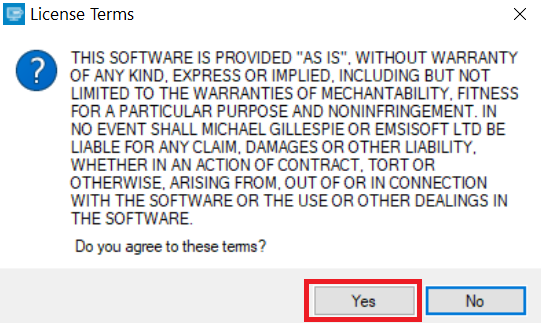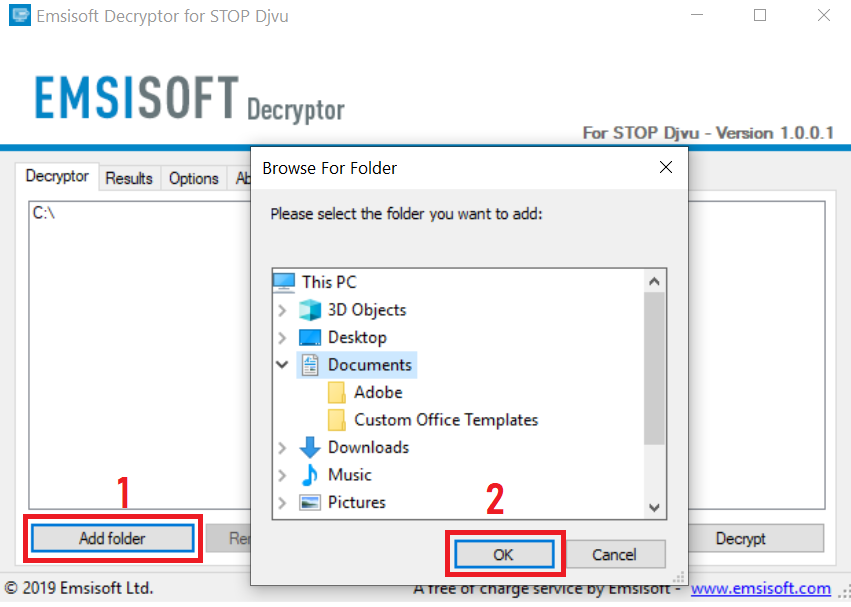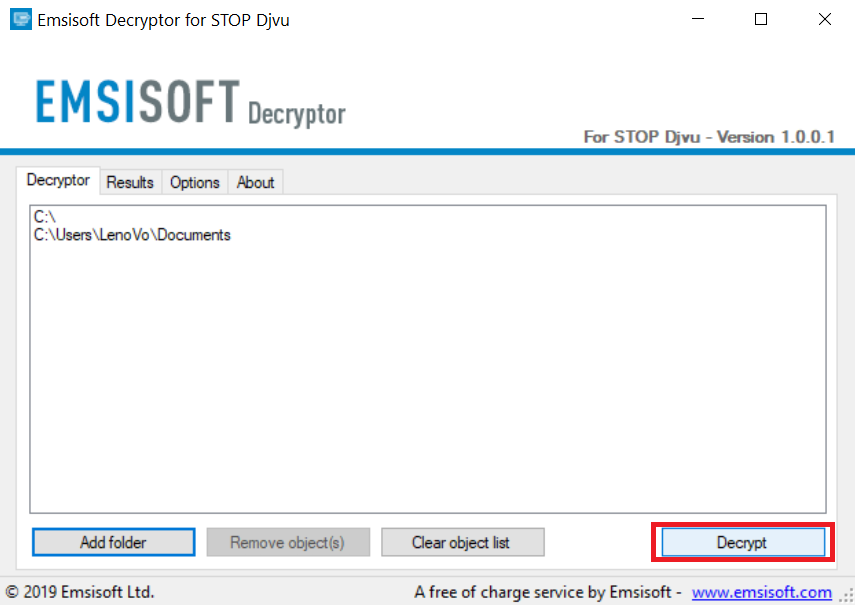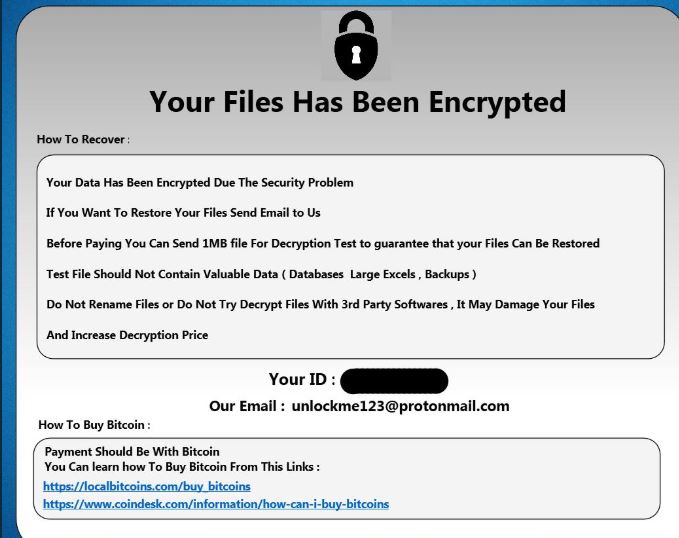What is .Lazarus virus .Lazarus virus is also known as .Lazarus ransomware and encrypts users’ files while asking for a ransom.
.Lazarus virus is a new malware threat that is descendant from the Ouroboros ransomware which is being sent to targets across the world. It is a complex ransomware that is distributed via various methods. It can lead to many serious system issues and can even install other malware threats. When it has completed running all of its modules it will proceed with the file encryption making sensitive user data inaccessible. The victims will be left with .Lazarus extension encrypted data and a ransomware note and/or a lockscreen instance.
style=”margin-top: 30px; text-align: left;”>

Threat Summary
| Name | .Lazarus virus |
| Type | Ransomware, Cryptovirus |
| Short Description | The ransomware encrypts files on your computer machine and demands a ransom to be paid to allegedly restore them. |
| Symptoms | The ransomware will blackmail the victims to pay them a decryption fee. Sensitive user data may be encrypted by the ransomware code. |
| Distribution Method | Spam Emails, Email Attachments |
| Detection Tool |
See If Your System Has Been Affected by malware
Download
Malware Removal Tool
|
User Experience | Join Our Forum to Discuss .Lazarus virus. |
| Data Recovery Tool | Windows Data Recovery by Stellar Phoenix Notice! This product scans your drive sectors to recover lost files and it may not recover 100% of the encrypted files, but only few of them, depending on the situation and whether or not you have reformatted your drive. |

.Lazarus virus – Detailed Description
The .Lazarus virus is a new threat based on the Ouroboros ransomware family. It is anticipated that this virus will be modeled after the typical model used by ransomware. There is no information available about the hacker or the criminal group behind it. Due to it being a newer iteration of a well-known threat we expect that it will follow the same distribution techniques as its predecessors. This includes the sending out of phishing messages via emails and the construction of hacker-made sites that attempt to manipulate the victims into believing that they are receiving notifications from a legitimate service or company. When the users interact with any of them the associated .Lazarus virus engine will be started.
In addition the hackers can also embed the necessary installation scripts into file carriers — they can be various executables or documents that will lead to the virus infection once the users interact with them. A prime example is the inclusion of the virus macros across all popular document formats: text files, spreadsheets, presentations and databases. The other popular technique relies on the inclusion of the associated virus infection code in application installers. The hackers will generally target popular software that is frequently obtained by end users.
The .Lazarus virus can be contained also by browser hijackers which are dangerous plugins made for most of the popular web browsers. The criminals will post these extensions to the respective plugin reposoitories. They are commonly posted with fake user reviews and developer credentials and attempt to manipulate the victims into believing that they are installing an useful extension.
As soon as the .Lazarus virus is installed on a given computer it will execute its built-in sequence of malicious components. A common infiltration with ransomware of the Ouroboros family of threats may include any of the following:
- Data Retrieval — The .Lazarus virus can be set to extract a lot of sensitive information from the compromised hosts. This can include a list of the installed hardware components which is used to create a complete profile of the infected computers. What’s particularly worrying is when this module is programmed to collect information about the victims: the data can be used for various crimes such as identity theft and financial abuse.
- Persistent Threat Installation — If installed in an appropriate way the .Lazarus virus can be deployed as a persistent threat. This means that it will modify the boot options in order to start itself automatically as soon as the computer is powered on. It can also block access to the recovery boot options making it very hard to follow the usual manual user recovery guides.
- Windows Registry Changes — The .Lazarus virus can create new strings or edit out existing ones in the Windows Registry. The consequences of this action can lead to severe performance issuses, the inability to access certain functions and data loss.
- Additional Malware Delivery — The made infections can be used to deploy other viruses to the hosts: Trojans, cryptocurrency miners and etc.
As soon as the .Lazarus virus is deployed onto a given host and has executed all of its built-in modules it will start with the file encryption process. It will be based on a built-in list of target file type extensions that are to be affected: documents, multimedia files, backups, archives, databases and etc. All of the victim files will be renamed with the .Lazarus extension. A ransomware note will be crafted to manupulate the victims into paying the hackers a “decryption restore fee”.

.Lazarus virus – What Does It Do?
The .Lazarus virus is a crypto virus programmed to encrypt user data. As soon as all modules have finished running in their prescribed order the lockscreen will launch an application frame which will prevent the users from interacting with their computers. It will display the ransomware note to the victims.
You should NOT under any circumstances pay any ransom sum. Your files may not get recovered, and nobody could give you a guarantee for that.
The .Lazarus virus cryptovirus could be set to erase all the Shadow Volume Copies from the Windows operating system with the help of the following command:
→vssadmin.exe delete shadows /all /Quiet
If your computer device was infected with this ransomware and your files are locked, read on through to find out how you could potentially restore your files back to normal.

Remove .Lazarus virus
If your computer system got infected with the .Lazarus Files ransomware virus, you should have a bit of experience in removing malware. You should get rid of this ransomware as quickly as possible before it can have the chance to spread further and infect other computers. You should remove the ransomware and follow the step-by-step instructions guide provided below.
- Step 1
- Step 2
- Step 3
- Step 4
- Step 5
Step 1: Scan for .Lazarus virus with SpyHunter Anti-Malware Tool



Ransomware Automatic Removal - Video Guide
Step 2: Uninstall .Lazarus virus and related malware from Windows
Here is a method in few easy steps that should be able to uninstall most programs. No matter if you are using Windows 10, 8, 7, Vista or XP, those steps will get the job done. Dragging the program or its folder to the recycle bin can be a very bad decision. If you do that, bits and pieces of the program are left behind, and that can lead to unstable work of your PC, errors with the file type associations and other unpleasant activities. The proper way to get a program off your computer is to Uninstall it. To do that:


 Follow the instructions above and you will successfully delete most unwanted and malicious programs.
Follow the instructions above and you will successfully delete most unwanted and malicious programs.
Step 3: Clean any registries, created by .Lazarus virus on your computer.
The usually targeted registries of Windows machines are the following:
- HKEY_LOCAL_MACHINE\Software\Microsoft\Windows\CurrentVersion\Run
- HKEY_CURRENT_USER\Software\Microsoft\Windows\CurrentVersion\Run
- HKEY_LOCAL_MACHINE\Software\Microsoft\Windows\CurrentVersion\RunOnce
- HKEY_CURRENT_USER\Software\Microsoft\Windows\CurrentVersion\RunOnce
You can access them by opening the Windows registry editor and deleting any values, created by .Lazarus virus there. This can happen by following the steps underneath:


 Tip: To find a virus-created value, you can right-click on it and click "Modify" to see which file it is set to run. If this is the virus file location, remove the value.
Tip: To find a virus-created value, you can right-click on it and click "Modify" to see which file it is set to run. If this is the virus file location, remove the value.
Before starting "Step 4", please boot back into Normal mode, in case you are currently in Safe Mode.
This will enable you to install and use SpyHunter 5 successfully.
Step 4: Boot Your PC In Safe Mode to isolate and remove .Lazarus virus





Step 5: Try to Restore Files Encrypted by .Lazarus virus.
Method 1: Use STOP Decrypter by Emsisoft.
Not all variants of this ransomware can be decrypted for free, but we have added the decryptor used by researchers that is often updated with the variants which become eventually decrypted. You can try and decrypt your files using the instructions below, but if they do not work, then unfortunately your variant of the ransomware virus is not decryptable.
Follow the instructions below to use the Emsisoft decrypter and decrypt your files for free. You can download the Emsisoft decryption tool linked here and then follow the steps provided below:
1 Right-click on the decrypter and click on Run as Administrator as shown below:

2. Agree with the license terms:

3. Click on "Add Folder" and then add the folders where you want files decrypted as shown underneath:

4. Click on "Decrypt" and wait for your files to be decoded.

Note: Credit for the decryptor goes to Emsisoft researchers who have made the breakthrough with this virus.
Method 2: Use data recovery software
Ransomware infections and .Lazarus virus aim to encrypt your files using an encryption algorithm which may be very difficult to decrypt. This is why we have suggested a data recovery method that may help you go around direct decryption and try to restore your files. Bear in mind that this method may not be 100% effective but may also help you a little or a lot in different situations.
Simply click on the link and on the website menus on the top, choose Data Recovery - Data Recovery Wizard for Windows or Mac (depending on your OS), and then download and run the tool.
.Lazarus virus-FAQ
What is .Lazarus virus Ransomware?
.Lazarus virus is a ransomware infection - the malicious software that enters your computer silently and blocks either access to the computer itself or encrypt your files.
Many ransomware viruses use sophisticated encryption algorithms to make your files inaccessible. The goal of ransomware infections is to demand that you pay a ransom payment to get access to your files back.
What Does .Lazarus virus Ransomware Do?
Ransomware in general is a malicious software that is designed to block access to your computer or files until a ransom is paid.
Ransomware viruses can also damage your system, corrupt data and delete files, resulting in the permanent loss of important files.
How Does .Lazarus virus Infect?
Via several ways..Lazarus virus Ransomware infects computers by being sent via phishing emails, containing virus attachment. This attachment is usually masked as an important document, like an invoice, bank document or even a plane ticket and it looks very convincing to users.
Another way you may become a victim of .Lazarus virus is if you download a fake installer, crack or patch from a low reputation website or if you click on a virus link. Many users report getting a ransomware infection by downloading torrents.
How to Open ..Lazarus virus files?
You can't without a decryptor. At this point, the ..Lazarus virus files are encrypted. You can only open them once they are decrypted using a specific decryption key for the particular algorithm.
What to Do If a Decryptor Does Not Work?
Do not panic, and backup the files. If a decryptor did not decrypt your ..Lazarus virus files successfully, then do not despair, because this virus is still new.
Can I Restore "..Lazarus virus" Files?
Yes, sometimes files can be restored. We have suggested several file recovery methods that could work if you want to restore ..Lazarus virus files.
These methods are in no way 100% guaranteed that you will be able to get your files back. But if you have a backup, your chances of success are much greater.
How To Get Rid of .Lazarus virus Virus?
The safest way and the most efficient one for the removal of this ransomware infection is the use a professional anti-malware program.
It will scan for and locate .Lazarus virus ransomware and then remove it without causing any additional harm to your important ..Lazarus virus files.
Can I Report Ransomware to Authorities?
In case your computer got infected with a ransomware infection, you can report it to the local Police departments. It can help authorities worldwide track and determine the perpetrators behind the virus that has infected your computer.
Below, we have prepared a list with government websites, where you can file a report in case you are a victim of a cybercrime:
Cyber-security authorities, responsible for handling ransomware attack reports in different regions all over the world:
Germany - Offizielles Portal der deutschen Polizei
United States - IC3 Internet Crime Complaint Centre
United Kingdom - Action Fraud Police
France - Ministère de l'Intérieur
Italy - Polizia Di Stato
Spain - Policía Nacional
Netherlands - Politie
Poland - Policja
Portugal - Polícia Judiciária
Greece - Cyber Crime Unit (Hellenic Police)
India - Mumbai Police - CyberCrime Investigation Cell
Australia - Australian High Tech Crime Center
Reports may be responded to in different timeframes, depending on your local authorities.
Can You Stop Ransomware from Encrypting Your Files?
Yes, you can prevent ransomware. The best way to do this is to ensure your computer system is updated with the latest security patches, use a reputable anti-malware program and firewall, backup your important files frequently, and avoid clicking on malicious links or downloading unknown files.
Can .Lazarus virus Ransomware Steal Your Data?
Yes, in most cases ransomware will steal your information. It is a form of malware that steals data from a user's computer, encrypts it, and then demands a ransom in order to decrypt it.
In many cases, the malware authors or attackers will threaten to delete the data or publish it online unless the ransom is paid.
Can Ransomware Infect WiFi?
Yes, ransomware can infect WiFi networks, as malicious actors can use it to gain control of the network, steal confidential data, and lock out users. If a ransomware attack is successful, it could lead to a loss of service and/or data, and in some cases, financial losses.
Should I Pay Ransomware?
No, you should not pay ransomware extortionists. Paying them only encourages criminals and does not guarantee that the files or data will be restored. The better approach is to have a secure backup of important data and be vigilant about security in the first place.
What Happens If I Don't Pay Ransom?
If you don't pay the ransom, the hackers may still have access to your computer, data, or files and may continue to threaten to expose or delete them, or even use them to commit cybercrimes. In some cases, they may even continue to demand additional ransom payments.
Can a Ransomware Attack Be Detected?
Yes, ransomware can be detected. Anti-malware software and other advanced security tools can detect ransomware and alert the user when it is present on a machine.
It is important to stay up-to-date on the latest security measures and to keep security software updated to ensure ransomware can be detected and prevented.
Do Ransomware Criminals Get Caught?
Yes, ransomware criminals do get caught. Law enforcement agencies, such as the FBI, Interpol and others have been successful in tracking down and prosecuting ransomware criminals in the US and other countries. As ransomware threats continue to increase, so does the enforcement activity.
About the .Lazarus virus Research
The content we publish on SensorsTechForum.com, this .Lazarus virus how-to removal guide included, is the outcome of extensive research, hard work and our team’s devotion to help you remove the specific malware and restore your encrypted files.
How did we conduct the research on this ransomware?
Our research is based on an independent investigation. We are in contact with independent security researchers, and as such, we receive daily updates on the latest malware and ransomware definitions.
Furthermore, the research behind the .Lazarus virus ransomware threat is backed with VirusTotal and the NoMoreRansom project.
To better understand the ransomware threat, please refer to the following articles which provide knowledgeable details.
As a site that has been dedicated to providing free removal instructions for ransomware and malware since 2014, SensorsTechForum’s recommendation is to only pay attention to trustworthy sources.
How to recognize trustworthy sources:
- Always check "About Us" web page.
- Profile of the content creator.
- Make sure that real people are behind the site and not fake names and profiles.
- Verify Facebook, LinkedIn and Twitter personal profiles.



